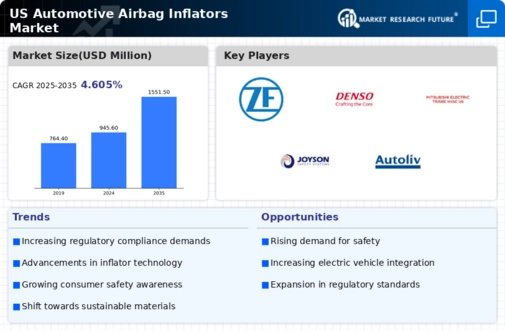Advancements in Material Technology
Advancements in material technology are playing a crucial role in shaping the automotive airbag-inflators market. The development of lighter and more durable materials allows for the creation of more efficient inflators that can deploy faster and more reliably. For instance, the use of high-strength polymers and composites can reduce the overall weight of airbag systems, contributing to improved vehicle performance and fuel efficiency. As manufacturers increasingly adopt these innovative materials, the automotive airbag-inflators market is expected to witness growth. This trend not only enhances safety but also aligns with the automotive industry's broader goals of sustainability and efficiency.
Increasing Vehicle Production Rates
The automotive airbag-inflators market is experiencing growth driven by rising vehicle production rates in the US. As manufacturers ramp up production to meet consumer demand, the need for safety features, including airbags, becomes paramount. In 2025, the US automotive industry is projected to produce approximately 12 million vehicles, which correlates with a heightened demand for airbag-inflators. This surge in production not only reflects consumer preferences for safety but also compels manufacturers to invest in advanced airbag technologies. Consequently, the automotive airbag-inflators market is likely to benefit from this trend, as automakers prioritize the integration of reliable and efficient inflators in their vehicles to enhance occupant safety and comply with evolving safety regulations.
Consumer Awareness of Safety Features
Consumer awareness regarding vehicle safety features is a significant driver for the automotive airbag-inflators market. As more individuals prioritize safety when purchasing vehicles, the demand for advanced airbag systems has increased. Surveys indicate that over 70% of US consumers consider airbags a critical safety feature, influencing their purchasing decisions. This heightened awareness compels manufacturers to innovate and improve airbag-inflator designs, ensuring they meet consumer expectations. The automotive airbag-inflators market is thus likely to expand as manufacturers respond to this demand by developing more efficient and reliable inflators, ultimately enhancing vehicle safety and consumer confidence.
Growth of Electric and Autonomous Vehicles
The growth of electric and autonomous vehicles is emerging as a significant driver for the automotive airbag-inflators market. As the automotive landscape evolves, manufacturers are integrating advanced safety features into electric and autonomous models. These vehicles often require specialized airbag systems that can accommodate unique design elements and safety protocols. The increasing production of electric vehicles, projected to reach 3 million units in the US by 2025, necessitates the development of innovative airbag-inflators tailored to these new technologies. Consequently, the automotive airbag-inflators market is likely to benefit from this shift, as manufacturers adapt to the changing demands of the automotive industry.
Regulatory Pressure for Enhanced Safety Standards
Regulatory pressure for enhanced safety standards is a driving force in the automotive airbag-inflators market. The US government has implemented stringent regulations mandating the inclusion of advanced airbag systems in new vehicles. These regulations aim to reduce fatalities and injuries in accidents, thereby compelling manufacturers to prioritize the development of high-quality airbag-inflators. As compliance with these regulations becomes increasingly critical, the automotive airbag-inflators market is likely to expand. Manufacturers are investing in research and development to create inflators that not only meet but exceed regulatory requirements, ensuring the safety of occupants and enhancing their market competitiveness.
















Leave a Comment